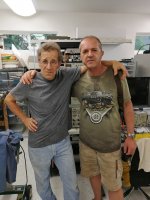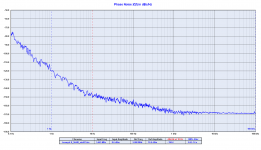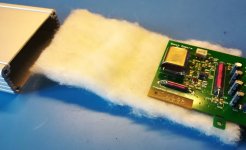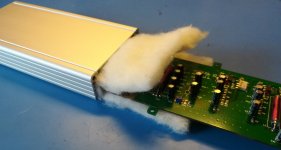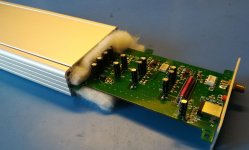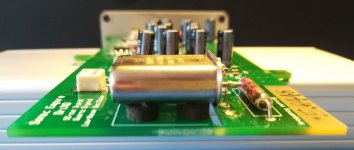You mean it won't if you are used to it?I wouldn't dare, may kill your tastebuds outright for days if you are not used to it.
Who cares, it sounds amazing. And is not for sale, I keep it for myself, I guess that makes me egotistic, right?
Seriously Andrea, if you would have the slightest amount of moral fiber you would not accept and encourage the most ridiculous ideas your customers are promoting here. Innocent souls went so far to pretend that suspending the oscillators by some rubber bands improve the sound, since the crystal vibrations are reduced, like in this thread you are losing money in: https://www.diyaudio.com/forums/group-buys/291925-tempered-master-clock-buy-128.html#post6653802 But I guess you think everything that supports your money losing endeavor is good for business, right?
I've seen in the last 20 years many people trying to promote a small business here, most of them were/are honest engineers (with or without the formal credentials) that found (or they thought they did) a niche in the tight audio market. You are fighting not only the First Principles, engineering good practices, and 100 years of audio development, but also with some of these individuals, which you are periodically demeaning and flaming, since you perceive them as a threat to your own business, do I need to quote examples? Adding this behavior to your unrealistic claims, and with the constant rejection to send any of your "amazing", "best in the world", etc... products for any independent, objective (aka measurements), evaluation (with shipping paid) tells pretty much the whole story about yourself and your "we".
Seriously, you are so presumptuous that you thought you could quickly build a stellar oscillator but in the end you have built a very poor one.
Seriously, there are true smart engineers like Bruce Griffiths, Jeremy Everard, John Miles, Enrico Rubiola and the guy at the left in the attached picture (RIP) who have spent years to build state of the art devices.
You thought you were smarter than them but you have miserabily failed.
I had no doubt.
Also my co-developer Roberto has suspended his oscillators by rubber bands, what is the problem?
Although the 1/f3 close in phase noise of an oscilallator is dominated by the random walk of the crystal there are other factors which can affects the performance like just vibrations and even the moving air.
So there is nothing wrong.
I have already suggest you the link Rubiola.org
Seriously, my "we" is just me and my partner in development Roberto, you can ask Gerhard if Roberto does exist or if he his my Dr. Jekyll e Mr. Hyde.
Since Jocko Homo was banned from this forum he stopped writing and also reading this forum.
Just another hobbyist like me who likes diy audio.
I avoid to write what he think about those like you but you can imagine.
Seriously, you are so frustrated for designing such a poor oscillator that you climb the mirrors disputing the reliability of my measurements.
I attach the phase noise plot of the oscillator I have sent to George alias Joseph K.
He owns the suitable tool to repeat the measurement so he can validate mine.
Seriously, a minimum of humility would not hurt.
Attachments
A reminder to all, the speed of sound varies with air temperature (~0.1%/F). Any conditioned closed space contains random air currents and with typical HVAC systems the exit temperatures of the vents are several degrees larger or smaller than the average temperature of the room. There is also the 300BTU or so of each person in the room. So IMO these close in jitter specs are not realizable due to the non-uniform and time variant properties of the environment. These effects have been measured.
Sorry Scott, I'm not sure I have understood correctly, do you think the Timepod 5330A (now Microsemi) cannot measure -150dBc at 10 Hz or -120dBc at 1 Hz from the carrier?
As far as oscillators go for D/A or CD players, the most important spec is short term stability. That means it would be pretty hard to beat an ovenized SC cut crystal without frequency control. That's all you would need for the ultimate clock. Any constant frequency deviation results in frequency differences too small to worry about.
If you were to lock it to the GPS, you would definitely want it in hold-over mode during playback. The very last thing you want is a frequency correction during system use!
A simple quartz crystal oscillator does extremely well for playback once the system is stable in temperature. It isn't that bad during warmup either. That's assuming a clean power supply of course.
-Chris
Hi Chris,
the oven does not matter, we have measured the same SC-Cut crystal oscillator with and without the ove and the short term stability did not change, the close in phase noise was exactly the same.
Of course, with the oven you also get a spectacular Allan deviation while without it the long term stability is poor.
But in audio we don't care about long term stability, unless you have to sync multiple time domains.
Wondering if noise modulation in high loop gain amplifiers is one problem.
I would have to file that as 'FUD of the week' without something other than a sighted listening report. Occam is as ever not in your favour on this one.
I like some of my food extra spicy many here would find inedible, preference is subjective.
A very spicy Dover sole is not an accurate rendition of the dish. Poor analogy in this context.
I should also note there are quite a few people on here who like a kick in their dinner so you might not be alone in your preferences, at least when the dish calls for it...
So much turd flinging XD
Nice phase noise graph, Mr Mori 👍
It does not produce the same effects as jitter... Consider a single pulse of known amplitude, jitter will change its length, thus its energy. Variation in propagation speed will not change its energy. Doppler effect will compress or expand the pulse in time, but it will also not change its energy. So I disagree with this analogy, I think it's too simple.
Also jitter does evil things to sigma delta DACs, like folding some of the HF noise down.
Back when I did a shootout between $1 oscillators, with my 50 cents phase noise rig, consisting of a NOR gate used as a mixer, putting a demakup cotton ball on the clock reduced low frequency phase noise substantially, by keeping it at a stable temperature. There was also a big difference in sound quality between these cheap clocks. The one with lowest jitter sounded best.
Experiment: as test signal, use a 10kHz low amplitude sine plus a 50Hz high amplitude sine that plays for a few seconds then stops. Plot amplitude and phase of fundamental and harmonics of 10kHz versus time.
Nice phase noise graph, Mr Mori 👍
A reminder to all, the speed of sound varies with air temperature (~0.1%/F).
It does not produce the same effects as jitter... Consider a single pulse of known amplitude, jitter will change its length, thus its energy. Variation in propagation speed will not change its energy. Doppler effect will compress or expand the pulse in time, but it will also not change its energy. So I disagree with this analogy, I think it's too simple.
Also jitter does evil things to sigma delta DACs, like folding some of the HF noise down.
Although the 1/f3 close in phase noise of an oscilallator is dominated by the random walk of the crystal there are other factors which can affects the performance like just vibrations and even the moving air.
Back when I did a shootout between $1 oscillators, with my 50 cents phase noise rig, consisting of a NOR gate used as a mixer, putting a demakup cotton ball on the clock reduced low frequency phase noise substantially, by keeping it at a stable temperature. There was also a big difference in sound quality between these cheap clocks. The one with lowest jitter sounded best.
This excludes the time domain.
Experiment: as test signal, use a 10kHz low amplitude sine plus a 50Hz high amplitude sine that plays for a few seconds then stops. Plot amplitude and phase of fundamental and harmonics of 10kHz versus time.
Also, no-one bothered with my little quiz... There's a surprise if you answer 
Back when I did a shootout between $1 oscillators, with my 50 cents phase noise rig, consisting of a NOR gate used as a mixer, putting a demakup cotton ball on the clock reduced low frequency phase noise substantially, by keeping it at a stable temperature. There was also a big difference in sound quality between these cheap clocks. The one with lowest jitter sounded best.
Indeed this is the way we install our oscillator inside the enclosure.
The crystal is placed on a pair of neoprene discs and its terminals are connected using thin copper wire.
This minimizes the close in phase noise.
Attachments
Andrea_mori, I think you are on a positive track and I personally would take seriously Markw4 on this thread. Real audio designers know that standard measurements do NOT consistently reveal whether a product will sound best.
Hi John,
I agree, the modern measurements are almost the same which failed in the early '70s'.
IMHO they are useful for understanding if there are gross errors, but they tell almost nothing about the system's ability to reproduce the sound event in a realistic way.
Hi Andrea,
We agree completely on oscillator stability. You're right, an oven is icing on the cake.
wrt measurements, if you know how to interpret them, and not blindly go for the lowest numbers, measurements will steer you correctly to good sound. John's statement is too general and is as such, misleading I think. I do have great respect for John and his work, but he plays his cards very close to his chest.
Remember, I design with tubes as well. The lowest numbers do not tell the entire story. I know this well, but you have to have an accurate picture of what your circuit is doing in order to be guided. So measurements in concert with what you hear will bring you to a good sounding product. I don't think that John would disagree with that in his own mind.
-Chris
We agree completely on oscillator stability. You're right, an oven is icing on the cake.
wrt measurements, if you know how to interpret them, and not blindly go for the lowest numbers, measurements will steer you correctly to good sound. John's statement is too general and is as such, misleading I think. I do have great respect for John and his work, but he plays his cards very close to his chest.
Remember, I design with tubes as well. The lowest numbers do not tell the entire story. I know this well, but you have to have an accurate picture of what your circuit is doing in order to be guided. So measurements in concert with what you hear will bring you to a good sounding product. I don't think that John would disagree with that in his own mind.
-Chris
Of course not. Measuring devices don't know what you like best.Andrea_mori, I think you are on a positive track and I personally would take seriously Markw4 on this thread. Real audio designers know that standard measurements do NOT consistently reveal whether a product will sound best.
Except when evaluating syn08's?I don't reject measurements, as you see we measured our oscillators before listening to them.
Hi Kastor,
[--snip--]
Don't get distracted by things that don't affect anything in a significant way. Look after the big problems first, then worry about the tiny stuff.
-Chris
Hi Chris,
Yes, I already spent a little time in the past investigating areas in audio which are not important, for example mp3 versus flac versus 192 kHz / DXD / DSD.
If I increase the volume in a hearing test I can hear up to 19 kHz, so I don't need the bat frequency of DXD files with ultrasonic tweeters, so the bats can hear the cymbals natural sound extending up to 50 kHz or higher. If I investigate deeper into audio, I already noticed someone in France or Japan will say that something in the human skin can pick up the 50 kHz frequency, so if I aim the ultrasonic tweeter at my skin then it will be transferred into the central nervous system, somehow.. so these DXD files & ultrasonic tweeters can provide the 26 kHz overtone of a violin, or the 50 kHz ring of a cymbal, or some other cymbal-like instruments... to my skin.
Ok I don't believe that.
I also don't believe in the importance of power supply or cables. Actually I had a high quality Pioneer / Sansui type integrated amp which picked up all the noise in my power supply once & it was just like a little intermittent noise on the high quality sound, it's just like some buzzing & whirr sometimes, like if a very high quality TV & video have some noise on the screen, or the black background is a little grey, or something in the color green is off so it's all light green, it's not important in the sense of the default sound quality / video quality ..... it's just a tiny noisiness introduced into the default, so when the default is very high quality then cables & power supply are like super low importance.
I don't claim to have all the answers at this point. I am just trying to consider possible physical explanations other than to assume that everything is explained by human hallucination. To my ears, AHB2 buries some musical details in some kind of noise. That seems like what might be happening when other people have described some low distortion circuits as loosing details, "some of the details just disappear." So they argue that feedback loses information. Maybe it just hides information. Not due to basic control theory of course, but real circuits are not ideal. The model in an engineer's head is only so good at representing the physical world.
The first recorded observation of a soliton wave preceded its physical scientific explanation. It turned out not to be a hallucination. It took time to figure out the cause.
Regarding critics, its normal for some people to scoff when their preexisting beliefs are at stake.
So which part of this is the x axis, which part is the Y?
This is why nothing you say gets taken seriously, you can’t answer questions without sophistry.
But still won't remove the smell of that snake oil.Rinse and repeat.

[--snip--]
It's time to drop the idea that you can hear things you can't measure. That statement is completely false today.
[--snip--] your results will vary depending on day, time, mood, amount of sleep. [--snip--]
-Chris
Yes humans can change their mind about various equipment, especially when they find something superior. On the other hand lab equipment doesn't change it's mind very often.
Another situation, if you raise the price from let's say $500 to $5,000 & make the amplifier look nicer, with some kind of special marketing, then the idea is that expectation effect can cause the human to think the amplifier sounds much better than it actually sounds. (for example I criticized some simple DAP companies which took the DAP from another company then just changed the brand & raised the price from $50 to $250 when the inside is exactly the same... if you open the product & it's exactly the same inside & the software & interface is exactly the same like they didn't do anything at all aside from changing the shell / color & the brand... I just raised noticing this with two companies, then one of the forum admin contacted me [at a different forum, not here] since this company was his paying customer & he said his paying customer (like sponsor / advertizing, paying the forum $500 to $1000 a month or whatever) might sue him, or something like that...)
He wrote they might sue him since I'm criticizing this company or their antics in the forum. I was going to talk to the admin in the phone, although I think they just wanted me to delete my posts & I didn't do that so they banned me, Lol.
- Status
- Not open for further replies.
- Home
- Member Areas
- The Lounge
- Sound Quality Vs. Measurements
